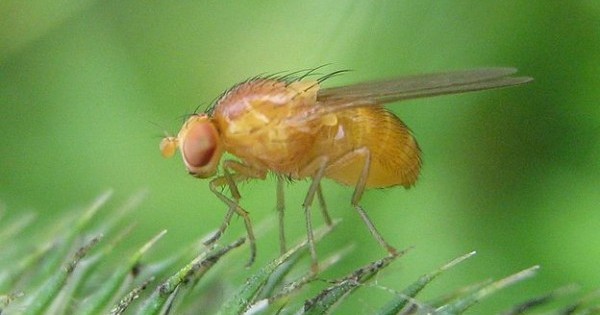
We don’t invite fruit flies to the family reunion, but they arrive uninvited, billowing up from the fresh peaches. We may have a few things in common, but we don’t care. Go away.
We both have eyes. The buggy eyes of fruit flies (Drosophila melanogaster) have about 800 facets (called ommatidia), each peering out from a fixed position. What could be more different from our eyes? Our eyes each have one lens that we move this way and that. Here, it was once thought, is a perfect example of convergent evolution. During the process of evolution through natural selection, the same function evolves independently in unrelated organisms, under similar environmental pressures. In animals, sight confers such a huge survival advantage that it’s no wonder the capacity to see evolved more than once. Makes perfect sense.
But it didn’t happen that way. Our eyes and bugs’ eyes evolved from the same ancestral light-sensitive cells, the same ancestral organism, the same ancestral genes.
A gene is a strand of DNA that holds the code for the amino acids that make proteins. And proteins do the work of the body. Any given human cell—we have trillions of them—holds our entire genome in its nucleus. But in each cell only certain genes are expressed; all others are repressed. So, for example, we salivate with saliva and not blood because the genes inside the cells inside our mouth express the amino acids that make the proteins that make saliva.
Certain genes code for proteins whose job it is to clamp down on or get off other genes, repressing them or allowing their work to go forward. These proteins are switches. Each gene may have 10 or more switches (according to Sean B. Carroll in Endless Forms Most Beautiful).
During fetal development, gene expression in embryonic stem cells sets in motion the development of all the different body parts, all in the right places as their switches switch them on or off. The enormous number of switches explains why organisms with highly similar genomes (flies, mice, us) turn out so different.
Back to eyes. In mice, fruit flies, humans, and other species, the gene that codes for the protein that switches on eye development is remarkably similar. And within that gene, there exists a region that is identical in humans and mice and virtually identical in humans and fruit flies. This region of DNA was conserved over millions of years of evolution. In other words, as organisms evolved into dozens of species, they all retained this region of this gene exactly as it was in the ancestor organism. Indeed, scientists have inserted the mouse edition into fruit-fly wings, and the gene works perfectly well in wing cells to switch on the fruit-fly genes that make eyes. The wings grow eyes.
We and the fruit fly evolved from the same ancient life form, and that ancestor gave us eyes. So we are related to fruit flies. Does that give them rights at our family picnic? I think not.

